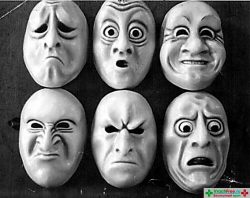A Psychopathological Perspective in Neo-Colonial Era. The thesis shall be published in episodes. A detail of references shall be given in the last episode.
Psychopathology of Anger and Apathy
Psychopathology is a scientific study of “nature and aetiology of mental disorders” (Skodol, Shaffer & Gurland, 2003 p 2..509). Unlike some other ailments studied in medical science, mental disorders have no definitive aetiologies. It would be interesting to look at the definition of mental disorders as they are defined by American Psychiatric Association in Diagnostic and Statistical Manual of Mental Disorders, (DSM-IV TR) “each of the mental disorders is conceptualized as a clinically significant behavioral or psychological syndrome or pattern that occurs in an individual and that is associated with present distress (e.g., a painful symptom) or disability (i.e., impairment in one or more important areas of functioning) or with a significantly increased risk of suffering death, pain, disability, or an important loss of freedom” (American Psychiatric Association 2000, p.xxxi). This definition is further explained “neither deviant behaviors (e.g., political, religious, or sexual) nor conflicts that are primarily between the individual and society are mental disorders unless the deviance or conflict is a symptom of a dysfunction in the individual” (APA 2000). This explanation has failed to draw attention to the “dysfunction” caused by the conflict between individual and society.
Anger, generally is a difficult emotional response to define in psychopathology. The context and manifestation help in defining different and often overlapping shades of anger, i.e., irritability, animus, rage, hostility, hatred, impulsivity and aggression etc. However, this fuzzy and collate of emotional response is a state which is characterized by heightened vigilance in response to a sense of threat (Kohn & Keller, 2003; Raber & Reber, 2001). The severity of response depends at the perception of nature and level of threat.
Apathy is a state of emotional numbness manifested in detachment and indifference (Kohn & Keller, 2003, p. 2. 617). Abulia, is one the severe forms of apathy in which ability to decide about goals and act accordingly is diminished. Avolition is a state of desiring to follow a set goal but without any energy available for it. Avolition is one of the symptoms of schizophrenia.
Well known psychoanalyst Harry Stack Sullivan, in his Theory of Personality Development referred to apathy as a defence mechanism through which the awareness around conflict with environment is trimmed down to lessen the susceptibility to interpersonal tension and anxiety (Mullahy 1952.p.617).
Different forms of anger and apathy can be easily seen in diagnostic criteria of several mental disorders. Irritability is a frequently reported and observed clinical symptom of Anxiety Disorders and Mood Disorder (depression). In psychopathology, irritability is defined as a state of reduced control over temper which others may notice through petulant “verbal or behavioural outbursts, although the (irritable) mood may be present without observed manifestation” (Sims 1999, p. 306).
Holding hatred and animosity which does not sway in its severity and unyielding in its nature can be a symptom of Personality Disorders, like Paranoid Personality Disorder and Anankastic Personality. (Sims 1999)
Impulsivity and aggression have attracted quite a good amount of clinical interest and attention. These conditions are found in Disorders of Childhood, Personality Disorders, Schizophrenia and other Psychotic Disorders.
High levels of impulsivity, aggression and hostility are the major symptoms of three main childhood disorders. Attention Deficit Hyperactivity Disorder (ADHD), Conduct Disorders (CD) and Oppositional Defiant Disorders (ODD). Hyperactivity and impulsivity in ADHD “attenuate during late adolescence and adulthood” (APA, 2000, p.90). However, situation with other two disorders is different in adolescence. Particularly in the case of Conduct Disorders, the main sets of symptoms are; aggression to people and animals, destruction of property, deceitfulness or theft and serious violations of rules. The prevalence rate in the general population varies from less than 1% to 10% and “a substantial proportion continue to show behaviors in adulthood that meet the criteria for Antisocial Personality Disorder” (APA 2000. P.97). The list of symptoms of Oppositional Defiant Disorder (ODD) includes individual characteristics like, often loosing temper, often arguing with adults, often actively defying or refusing to comply with adults requests or rules, often deliberately annoying others, often blaming others for own mistakes, getting easily annoyed by others, often feeling angry and resentful and often being spiteful and vindictive. (APA, 2000). The prevalence rate of ODD is very high, between 2% to 16%. The most authentic diagnostic criterion given by APA in 2000 suggests that “the number of oppositional symptoms tends to increase with age. The disorder is more prevalent in males than females before puberty, but the rates appear to be equal after puberty. Symptoms are generally similar in each gender, except that males may have more confrontational behavior and more persistent symptoms” (APA, 2000, p.101). Alarming aspect is not the lethality of symptoms but the prevalence rate, poor prognosis and their moving into adolescence without any major decline in the severity of symptoms.
Personality Disorder (PD) is another entity which would have poor impulse control as an area to focus for diagnostic exercise. The DSM-IV-TR (APA, 2000) defines PD as “an enduring pattern of inner experience and behavior that deviates markedly from expectations of the individual’s culture” (p. 689). The areas of manifestation of symptoms are; 1) cognitive (i.e., ways of perceiving and interpreting self, other people and events), 2) affectivity (i.e., the range, intensity, lability, and appropriateness of  emotional response), 3) interpersonal functioning, and 4) impulse control. “Approximately 10 to 15% of the general population would be diagnosed with one of the 10 DSM-IV-TR personality disorders, excluding PDNOS” (Widiger & Mullins, 2003. p. 1605). A subtype of PD is called Paranoid Personality Disorder, a personality type which carries a pervasive pattern of distrust and suspiciousness to the extent of interpreting others behavior as malevolent. However, the most relevant type to the current discussion is Antisocial Personality Disorder (APD). APD is a “pervasive pattern of disregard for and violation of the rights of others occurring since age 15 years” (APA 2000). The notable symptoms are; repeated failure to conform to social norms and law, deceitfulness, lying and conning others, impulsivity, irritability and aggressiveness, reckless disregard for safety of self and others, consistent irresponsibility, lack of remorse by taking no responsibility, turning indifferent or rationalizing own acts of hurting, harming or mistreating others. Personality Disorders, in general are combination of different features and severity levels of anger and apathy.
emotional response), 3) interpersonal functioning, and 4) impulse control. “Approximately 10 to 15% of the general population would be diagnosed with one of the 10 DSM-IV-TR personality disorders, excluding PDNOS” (Widiger & Mullins, 2003. p. 1605). A subtype of PD is called Paranoid Personality Disorder, a personality type which carries a pervasive pattern of distrust and suspiciousness to the extent of interpreting others behavior as malevolent. However, the most relevant type to the current discussion is Antisocial Personality Disorder (APD). APD is a “pervasive pattern of disregard for and violation of the rights of others occurring since age 15 years” (APA 2000). The notable symptoms are; repeated failure to conform to social norms and law, deceitfulness, lying and conning others, impulsivity, irritability and aggressiveness, reckless disregard for safety of self and others, consistent irresponsibility, lack of remorse by taking no responsibility, turning indifferent or rationalizing own acts of hurting, harming or mistreating others. Personality Disorders, in general are combination of different features and severity levels of anger and apathy.
The co-morbidity of anger and apathy is there in schizophrenias and other psychotic disorders, as well. The characteristic symptoms of schizophrenias are conceptualized in two distinct categories; positive and negative symptoms. Hallucination, delusions and other distortions of normal functioning are considered as the positive symptoms “whereas the diminution or loss of normal functioning” (APA, 2000, p. 299) is thought of as a negative symptom. Flattening of affect (flat, unresponsive and immobile facial expression, poor eye contact and restricted body language), alogia (poverty of speech) and avolition (inability to initiate and maintain goal directed activities and little interest in taking part in the necessary work and social activities) can also be construed as symptoms which resemble apathy, particularly in their nature. Anxiety and anger are common symptoms of Paranoid Schizophrenia.
Some types of Mood Disorders would also have a combination of anger and apathy. These disorders would have “disabling disturbances in emotion” (Davison, Neale & Kring, 2004. p.268) and the symptoms would range from sadness, severe depression, lack of interest and inertia to unrealistic elation, irritability and aggressiveness of mania. The individual may have the extremes of these symptoms (can have either depression or mania) and may oscillate between the two extremes. Mood Disorder’s emotional disturbances are thought to be caused by a wide range of reasons. One possible and well researched reason was given by Seligman, which is called Learned Helplessness. With this notion Seligman tried implying a notion of some trauma and failure behind the symptoms of passivity, inertia and feeling and beliefs of being unable to control or change one’s life.
This theory began as a meditational learning theory formulated to explain the behavior of dogs who received inescapable electric shocks. Soon after receiving the first shock, the dog seemed to give up and passively accept the painful stimulation. Later, when the shocks could be avoided, these dogs did not acquire the avoidance response as efficiently and effectively as did control animals that had not experienced the inescapable shocks. Rather, most of them lay down in a corner and whined. On the basis of these observation, Seligman (1974) proposed that animals acquire a sense of helplessness which impairs their performance in stressful situations that can be controlled (Davison, Neale & Kring, 2004. p. 277).
Though, this theory faced theoretical difficulties in its application on depression but it does explain the reasons for indifference, apathy and social inaction.
Note: The Article has been published before and has not been updated.

Dr. Akhtar Ali Syed is a famous Psychologist and writer. He is currently working in Ireland as Principal Psychologist. He also has a keen interest in Philosophy, religions, History and Humanity.




